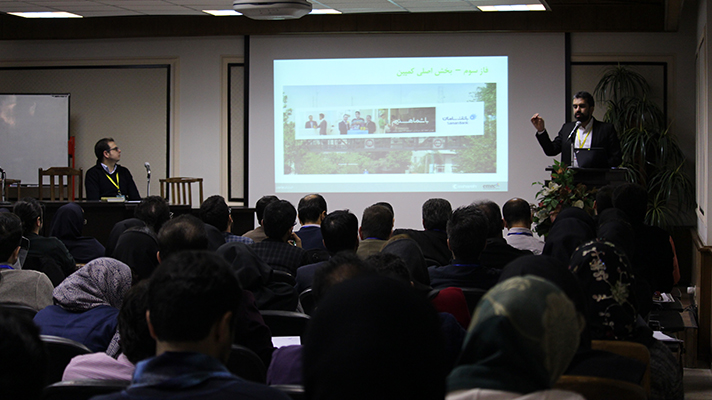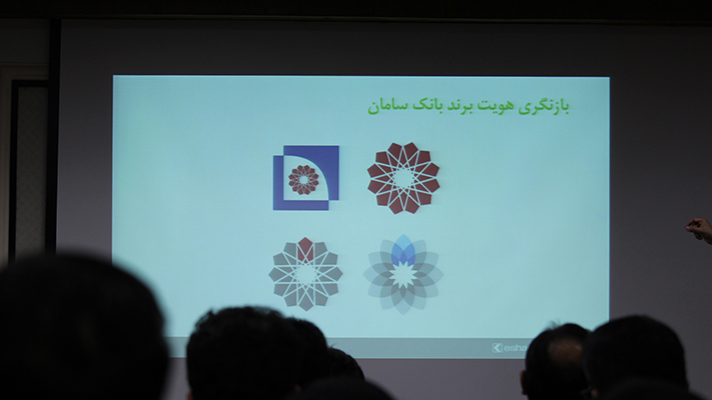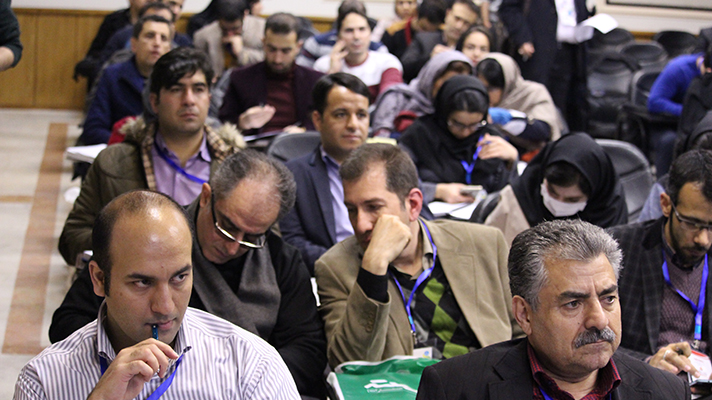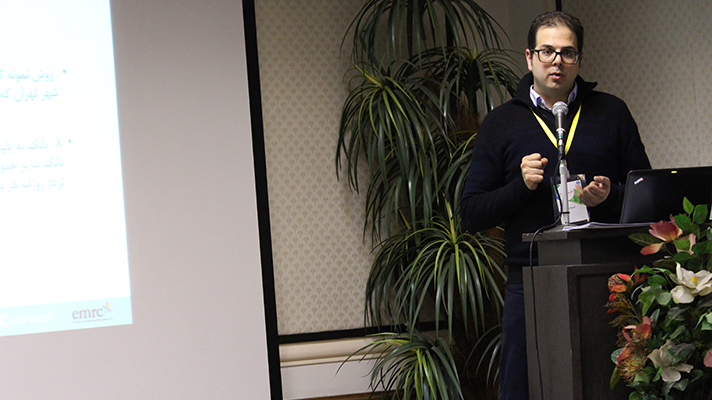
Saman Bank Rebranding: From 0 to 100!
As the market becomes increasingly competitive, many businesses are turning to branding: A process which could cost businesses dearly in terms of expenses and time if not fulfilled by experts. For the same reason, branding these days has been turned into an important challenge in Iran’s industry.
To deal with this challenge and offer solutions to overcome the problem, the dnaunion group held a workshop under the theme of “case study of a branding project from early stage of research up to implementation” on the sideline of the second marketing conference that was held with special focus on advertising.
The workshop was held by Babak Kazemi, the Brand Manager of Eshareh Advertising Company and Kamyar Emami, Managing Director of Emrooz Marketing Research Company (EMRC) from the dnaunion group.
Kazemi, in the first part of the workshop, elaborated on the various stages of branding and said: “Over the past several years, the term ‘brand’ has become widespread among the Iranian organizations. Many of these organizations consider the idea of branding synonymous with a new product. It is true that the major manifestation of a brand is its product but it is not solely confined to product. Brand is the inner impression of the audience of the brand (product, service, person, etc.) and brands should be able to present distinctive factors to the audiences: Factors, for the selection of which, one should be precise. Now, before discussing other points, let’s analyze three main functions of the brand. The three functions are:
One: Tracking
The customers would track the brands based on the labels, logos and generally the contact points of the brand with the audience
Two: Assurances
Not always the customers have enough information about the commodities they purchase but the names of the brands would give assurances to the customers about their buy. The customers based on their reliance on and trust in the brands, would use their subsequent products.
Three: Fixation
The customers would introduce themselves based on the brands they use. Many people these days judge others based on the type of brands they use. This is what fixation would bring to the brands and cause the customers to fall in love with brands. Meantime, businesses would increase their profit through raising the price of their products compared to similar goods with no brand.
These days businesses spend huge sums of money on branding and these expenses should be continuous and goal oriented. Part of these costs is for increasing their sales but its main part is for banding and for the audience to remember the brand. So working on brands is like working on the perceptual beliefs of the audience. On this basis, businesses should be more concentrated on the perceptual quality rather than the real quality. This same important point has caused the brands to make efforts by doing different activities in order to influence people’s belief towards their brands and in this way promote loyalty of the customers towards the brand. The brands focus their communicative activities on these beliefs and in this way the money they spend to promote their brands would result in earning money.
Kazemi added that contact points are among other important points that should be paid special attention to in businesses in the formation of their brands. The contact points of brands play the most important role in durability of the brand name and identification of a brand over another brand in the mind of the audience. Now, the more the contact points of a brand are in number and in sharing the same direction, they would bring the brand closer to success. With respect to the cases mentioned in order to change to a successful brand a systematic process should be taken which includes identification of the competitive position of the brand, compilation of its strategic approach and finally creation and development of the integrated contact points of the brand. This process from one perspective can be explained in the following form:
First Stage: Understanding the Project
Careful elucidation of the goals of the branding project and the points the customer or those giving orders are willing to be implemented.
Second Stage: Market Research
The research works and the data specify what the audiences want from the brands, in what status are the brands, and the potential for the competitive presence in the market.
Third Stage: Determining the Strategic Approach of the Brand
In terms of values, short term and long term objectives, the competitive position and the essence of the brand that should manifest itself in all the communicative activities of the brand and its contact points indirectly.
Fourth Stage: Development of the Design
At this stage the main elements of the brand will be specified: Elements such as the name, logo, organizational theme, color, etc. all of which should be in line with the essence of the brand.
Fifth Stage: Testing and Validation
At this stage, the idea of the experts in branding would be obtained both in terms of strategy and design about the compiled cases so that prior to entering into the next stage which is development of communicative elements, the accuracy of the process would be ensured.
Sixth Stage: Development of Visual and Verbal Elements
At this stage, all the contact points of the brand will be created. A lot of time and money should be devoted to this stage. If the brand fails to take the previous steps correctly, the output would proceed based on taste at this stage and due to lack of decision making authority many challenges would emerge. At this point the brands should trust the professionals. Also, at this stage all the visual elements ranging from packaging, documents and office items up to the cases relating to internal design of the organization or the uniform of the staff or designing of the website, etc. are done commensurate with the nature and demands of the brand. In addition, at this stage the identity book of the brand will take shape and will be put at the disposal of the organization.
Seventh Stage: Brand Unveiling Campaign
At this point, implementation will be specified in proportion with the identity of the brand and marketing objectives, advertising media, the budget and the schedule.
Eighth Stage: Reappraisal
At this point the message communicated by the brand will be evaluated and the brand should make sure that the projected image has taken shape on the minds of the audience.
Ninth Stage: Monitoring
At this stage the output of all the stages will be matched with the principles and regulations of the brand identity. This task must be done by professional people.
In the second part of his statements, Kazemi analyzed the process of formation and implementation of Saman Bank rebranding. He said Saman Bank before taking the rebranding path, in its marketing and advertising stages was more focused on the benefits of the services it rendered to the customers. Somehow, the Bank more relied on its updated performance and technology rather than creating emotional and sustainable bonds with its audience.
Meanwhile, in the course of different studies it was concluded that the Bank should establish stronger emotional communication channels with its customers and in proportion to its competitors introduce itself to its customers as a different bank. Such an approach brought the Bank to the pivotal idea and theme “we are with you”. The slogan “we are with you” is derived from the essence of the Saman Bank brand. This slogan suggested three meaning phases. From the first perspective, the slogan “we are with you” will address the audience and thus draw the attention. From the second perspective, this slogan says that it will remain with the customers and will always be beside them. The third perspective, which is in fact the ultimate goal of the Bank for the audience to always keep it on their minds, is presentation of this concept that it is due to the existence of the customers and because of their trust and relationship with them that we basically exist and find a reason for survival.
In the second part of the workshop, Kamyar Emami, Managing Director of EMRC from the dnaunion pointed to the importance of EMRC products and market research and said the market research companies from the beginning of the design of a campaign up to the implementation and evaluation by collecting and analyzing information play a fundamental role. Such companies deal with the analysis of the data and output of the campaign. Emrooz Marketing Research Company, in addition to the implementation of these activities, is regularly collecting data from the market and puts the information in the form of research products at the disposal of different companies at appropriate price. Some of the products offered by EMRC are in connection with the processes of the advertising field and their analysis.
The target group index or TGI is one of the products that deal with the market and the consumer from different dimensions. In this study, by using the “Choices” software comprehensive analyses are extracted from data about the audience and the customers
and put at the disposal of the advertising companies. These companies with respect to the information obtained could identify the media habits of their customers and could formulate better advertising programs for their customers. EMRC has been offering this product under the Kantar Company license for more than 10 years, covering 10,000 Iranian households in 17 major Iranian cities.
Ad*x or Advertising Monitoring: This product reviews advertising activities of the companies on TV and publications and based on a specific tariff every media measures the volume of the advertising budget of the market. Companies by using the result of the survey will realize how much advertising has been conducted in the market, under what atmosphere the advertising has been done and how much the companies have spent in this regard. Information of this product before designing the campaign and monitoring the process of the activity of the competitors of the companies in the market is more applicable. Since 10 years ago up to now Ad*x has been implemented and currently monitors advertising in 7 TV networks and more than 70 publications.
X*Trim: It is a research program designed and presented in line with measuring the number of TV audience in the field of advertising. By using this tool the variable rate of the TV audience at different hours can be evaluated.
Elsewhere in his remarks, Emami mentioned some points about the result of Saman Bank rebranding. He said the research on Saman Bank has quantitative approach and evaluation of cases such as the behavioral habits of the Saman Bank customers and measuring indicators regarding the released campaign were among the targets of this research.
Regarding the assessment of the campaign, different cases were evaluated such as:
One: Evaluation of the customer awareness with regard to the campaign
Two: Evaluation of the advertisements seen by the audience and the concept they have received from them
Three: Evaluation of the media where the audience has seen the advertisement of Bank Saman and attracted their attention
Emami said in conclusion that this research is quantitative and has been conducted with face-to-face interview method with respondents in busy branches of Saman Bank. The tool of collecting information has been questionnaires prepared with regard to the targets and for the sound collection of the information the necessary training was offered. The interviewers offered motivations to the audience to encourage them to respond. While showing them the advertisement they asked their opinion about the campaign. For this research, a big statistical sample was selected and for sampling the two-stage cluster method was used. The results of this research offered significant help to the idea processing group.
In the end, it must be noted that the workshop was welcomed by a large group of participants including many students and brand activists.









